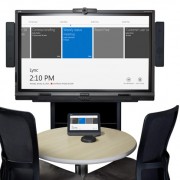Making it personal
Video is poised to undergo a steep growth curve as workgroup or desktop systems find a sweet spot in businesses of all sizes. And this period of strong market adoption is characterised by technology evolution, greater industry co-operation and strategic alliances.
Niall Dunne, country manager for Ireland with Polycom sees strong growth in non-traditional spaces such as ‘huddle rooms’.
“Companies are putting video systems into the middle of an open floor area, where the real work of the organisation is done, typically with small teams talking to other small teams.
“We’re not going to do away with business travel but we want to give people a viable alternative with tools that allow them to work collaboratively across the globe. Small and medium-sized businesses want these tools, as do large enterprises,” he said.
Polycom has developed technology to facilitate this workgroup-style approach and at a price point to suit most budgets. Its EagleEye Producer for example, is ideal for small huddle rooms and comes as a bolt on to the main video codec at an affordable price tag of €1,500.
“We’ve also launched Acoustic Bubble and Acoustic Fence, essentially creating an electronic fence around you and your work area so you can attenuate background noise,” he said. “We can put a boundary microphone in place and once you step outside that, we’ll cut that ambient noise out. It’s great for open plan areas.”
Smaller companies, who previously would have seen it as prohibitive to build dedicated video conferencing suites, are also adopting desktop level video.
“These solutions are typically cloud based, whether that’s Avaya Scopia, Cisco Jabber or ‘GoTo’ type services and they’re being driven by improvements on the network,” said Enda Doyle, director of business development and innovation for eircom Business Solutions.
“With increasing broadband speeds and eFibre connectivity now available, there’s more reliability on the network. We didn’t have that a few short years ago and it’s helping to fuel growth,” he said.
Liam O’Brien, head of business product management with Vodafone also sees a shift away from large telepresence systems.
“We’re moving to smaller, on premise solutions with a more compact form factor, high quality and a much better price point. We partner with Cisco and Avaya and see them responding to these market trends as part of technology evolution.
“Video is becoming more pervasive as price points come down. And this is helped by a move towards plug and play, quality solutions, which can be used in a desktop environment or even in a home office,” he said.
O’Brien also sees a lot more integration of technologies between platforms allowing different systems to co-exist.
“The whole industry is going through a transition. We’re all competing with each other but we’re all partnering with each other too. Vodafone is making substantial investments in hosted solutions at a voice and video level but vendors like Cisco and Microsoft from a different part of the ecosystem are converging around collaboration of voice and video. At this point, we’re probably collaborating but there’s also a competitive edge,” he said.
A case in point is Polycom’s multi-year alliance with Microsoft, which involves the co-development of products, using Microsoft’s Lync software layered on Polycom’s hardware from room systems to personal desktop units.
“Polycom RealConnect boasts native integration into Microsoft Lync to book your meetings, so you don’t step outside of the Microsoft workflow,” said Dunne.
“You book your meeting online in Exchange. Lync users join via a hyperlink and we can do bi-directional content sharing. Traditionally, I could send you content but you couldn’t send anything back. But now you can share your screens and content – there’s no step change and people don’t have to be re-trained.
“As we deliver that level of simplicity, video utilisation will be higher. For customers who have bought into the Microsoft stack, it’s easier to deploy Polycom than any other vendor,” he said.
Vodafone for its part will launch OneNet Business later this year, a converged multimedia proposition based on fixed, mobile and video. As a hosted platform, all endpoints effectively become the same with full integration to Microsoft Lync on the desktop but built on Vodafone core architecture.
“In our core network we’re converging into one architecture across all access types, which opens up opportunities for more productivity, better ease of use and flexibility across devices. It’s all part of one integrated system and represents significant capital investment,” said O’Brien.
The company has also done a soft launch of Google for Work, incorporating Google Hangouts – an instant messaging and video chat application for mobile and tablet devices.
“We’re launching this as part of our mid-market portfolio, for customers who are looking for easy to use email collaboration, document management and video. We recognise that Vodafone can’t do everything itself so we partner with best of breed companies,” he said.





Leave a Reply
Want to join the discussion?Feel free to contribute!